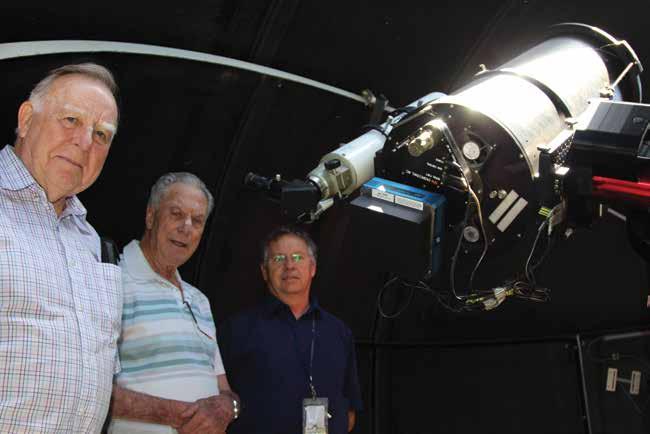
3 minute read
Astronomy & Space Science
It was a fantastic year in 2016 for great voyages of discovery in the solar system. New Horizons gave us amazing images of Pluto and is now on its way into the Kuiper belt to an object named 2014 MU69, which lies 1.6 billion kilometres away
Mr Bill Cooper Astronomy & Space Science Teacher
Evidence is mounting for underground oceans not only on Europa, but Gannymede, Callisto and even Pluto. The Mars Curiosity rover is currently driving its way up Mount Sharp uncovering the geological column and therefore the history of Mars. NASA’s OSIRIS-REx spacecraft is on its outbound journey from Earth to the asteroid Bennu for a sample return flight from a carbonaceous asteroid.
Rocket launching at Trinity has stepped up a pace with the help of Mr Phil Bloomfield who designed and manufactured a series of laser cut parts to facilitate speedy engine holder assembly. Our large V2 rocket had its first and last flight at Dowerin with the assistance of the Perth Advanced Rocketry guys. It powered away with a magnificent rumble to about two thousand feet but then turned in flight and flew a couple of kilometres down the road to bury itself in a nearby field. It was disappointing to see such a lot of work destroyed in a few seconds, but such is the nature of rockets.
As I write this the ESA lander mission to Mars, Schiaparelli, impacted the Martian surface at near terminal velocity after a failure in the final sequence of entry, descent and landing. So we are not alone in destructive landings.
Trinity’s missions to the stratosphere continue apace. Jordan Tyson (10.7) started the year with a new and novel payload container and Bailey Hughes (10.4) has improved on this design for our Semester 2 launch.
Every year Trinity College funds a student to attend the United Space School in the USA. For those students going into Year 11 next year and with a strong interest in Engineering, Space Science and Astronomy, it is an opportunity to collaborate with the best and brightest students from around the world. Anthony Carbone (10.8) was our 2016 representative. Max Thorniley (10.5) has been selected as the Trinity student to represent Australia at the United Space School in the USA in 2017.
We had the over-hyped supermoon on Monday 14 November — to quote Alan Pickup of the Guardian, “You will hear and read sensational claims that this makes the moon appear around 14% wider and 30% brighter than usual. These are false.”
21 MARCH
Dr Ravi N Margasahayam MS MBA, the NASA Co-Chair for ground safety review panel and payload safety engineer, came to Trinity and talked to the astronomy students about his life and how he went from being a small boy in an Indian village to working on NASA programs such as the space shuttle, Atlas, Delta, Titan, STARDUST and the ISS.
28 MAY
TG Tan gave an evening lecture to astronomy students on his work with the Perth Extra Solar Telescope Observatory and what is needed to be an exoplanet hunter.
17 NOVEMBER
Mr Jonathan Paxman, a senior lecturer at Curtin University gave a lecture to the Year 8 Astronomy boys and Science classes about the work of the Desert Fireball Network. It is a network of camera observatories across Australia with the objective of detecting meteors coming through the atmosphere and recovering meteorites on the ground. A meteorite recovery in Lake Eyre made a pretty big media splash at the beginning of this year!
Mr Bill Cooper
Astronomy & Space Science Teacher

Old Boy, Frank Pownall (’51) and Father Lawrence Bent visted the observatory 7 November











